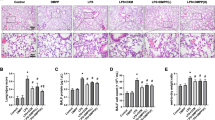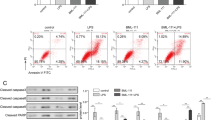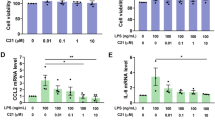Abstract
The release of inflammatory cytokines and chemokines and autophagy has been reported to be involved in the pathogenic mechanism of acute lung injury (ALI). Reportedly, alpha-7 nicotinic acetylcholine receptors (α7nAchR) might play a protective role in LPS-induced ALI. In the current research, we established LPS-induced ALI model in mice and α7nAchR agonist PNU-282987 improved LPS-induced injury. In MH-S cells, LPS stimulation inhibited, whereas α7nAchR agonist PNU-282987 enhanced the autophagy. α7nAchR agonist PNU-282987 protected MH-S cells from LPS-induced inflammation by reducing the concentrations of IL-6, TNF-α, and IL-1β. Finally, LPS stimulation dramatically inhibited MH-S cell viability but enhanced cell apoptosis, whereas PNU-282987 treatment exerted opposite effects; α7nAchR might regulate the cellular homeostasis via affecting the crosstalk between the autophagy and apoptosis in MH-S cells; in other words, α7nAChR agonist enhances MH-S cell autophagy and inhibits MH-S cell apoptosis. In conclusion, α7nAchR promote the protective autophagy in LPS-induced ALI model in mice and MH-S cells. The application of α7nAchR agonist is considered a potent target for LPS-induced ALI, which needs further clinical investigation.




Similar content being viewed by others
Data Availability
Please contact the authors for data requests.
References
Borovikova, L.V., S. Ivanova, M. Zhang, H. Yang, G.I. Botchkina, L.R. Watkins, H. Wang, N. Abumrad, J.W. Eaton, and K.J. Tracey. 2000. Vagus nerve stimulation attenuates the systemic inflammatory response to endotoxin. Nature 405 (6785): 458–462. https://doi.org/10.1038/35013070.
Chatterjee, P.K., M.M. Yeboah, O. Dowling, X. Xue, S.R. Powell, Y. Al-Abed, and C.N. Metz. 2012. Nicotinic acetylcholine receptor agonists attenuate septic acute kidney injury in mice by suppressing inflammation and proteasome activity. PLoS One 7 (5): e35361. https://doi.org/10.1371/journal.pone.0035361.
Choudhary, G.S., S. Al-Harbi, and A. Almasan. 2015. Caspase-3 activation is a critical determinant of genotoxic stress-induced apoptosis. Methods in Molecular Biology 1219: 1–9. https://doi.org/10.1007/978-1-4939-1661-0_1.
Cooper, K.F. 2018. Till death do us part: the marriage of autophagy and apoptosis. Oxidative Medicine and Cellular Longevity 2018: 4701275–4701213. https://doi.org/10.1155/2018/4701275.
de Jonge, W.J., and L. Ulloa. 2007. The alpha7 nicotinic acetylcholine receptor as a pharmacological target for inflammation. British Journal of Pharmacology 151 (7): 915–929. https://doi.org/10.1038/sj.bjp.0707264.
De Rosa, M.J., C. Esandi Mdel, A. Garelli, D. Rayes, and C. Bouzat. 2005. Relationship between alpha 7 nAChR and apoptosis in human lymphocytes. Journal of Neuroimmunology 160 (1–2): 154–161. https://doi.org/10.1016/j.jneuroim.2004.11.010.
Decuypere, J.P., J.B. Parys, and G. Bultynck. 2012. Regulation of the autophagic bcl-2/beclin 1 interaction. Cells 1 (3): 284–312. https://doi.org/10.3390/cells1030284.
Di Paolo, T., L. Gregoire, D. Feuerbach, W. Elbast, M. Weiss, and B. Gomez-Mancilla. 2014. AQW051, a novel and selective nicotinic acetylcholine receptor alpha7 partial agonist, reduces l-Dopa-induced dyskinesias and extends the duration of l-Dopa effects in parkinsonian monkeys. Parkinsonism & Related Disorders 20 (11): 1119–1123. https://doi.org/10.1016/j.parkreldis.2014.05.007.
Fan, H., R. Gu, and D. Wei. 2015. The alpha7 nAChR selective agonists as drug candidates for Alzheimer’s disease. Advances in Experimental Medicine and Biology 827: 353–365. https://doi.org/10.1007/978-94-017-9245-5_21.
Fan, K., L. Lin, Q. Ai, J. Wan, J. Dai, G. Liu, L. Tang, Y. Yang, P. Ge, R. Jiang, and L. Zhang. 2018. Lipopolysaccharide-induced dephosphorylation of AMPK-activated protein kinase potentiates inflammatory injury via repression of ULK1-dependent autophagy. Frontiers in Immunology 9: 1464. https://doi.org/10.3389/fimmu.2018.01464.
Han, S., and R.K. Mallampalli. 2015. The acute respiratory distress syndrome: from mechanism to translation. Journal of Immunology 194 (3): 855–860. https://doi.org/10.4049/jimmunol.1402513.
Harris, J., M. Hartman, C. Roche, S.G. Zeng, A. O'Shea, F.A. Sharp, E.M. Lambe, E.M. Creagh, D.T. Golenbock, J. Tschopp, H. Kornfeld, K.A. Fitzgerald, and E.C. Lavelle. 2011. Autophagy controls IL-1beta secretion by targeting pro-IL-1beta for degradation. The Journal of Biological Chemistry 286 (11): 9587–9597. https://doi.org/10.1074/jbc.M110.202911.
Hu, Y., J. Lou, Y.Y. Mao, T.W. Lai, L.Y. Liu, C. Zhu, C. Zhang, J. Liu, Y.Y. Li, F. Zhang, W. Li, S.M. Ying, Z.H. Chen, and H.H. Shen. 2016. Activation of MTOR in pulmonary epithelium promotes LPS-induced acute lung injury. Autophagy 12 (12): 2286–2299. https://doi.org/10.1080/15548627.2016.1230584.
Huang, L., C. Hu, H. Cao, X. Wu, R. Wang, H. Lu, H. Li, and H. Chen. 2018. MicroRNA-29c increases the chemosensitivity of pancreatic cancer cells by inhibiting USP22 mediated autophagy. Cellular Physiology and Biochemistry 47 (2): 747–758. https://doi.org/10.1159/000490027.
Jeong, J.K., and S.Y. Park. 2015. Neuroprotective effect of cellular prion protein (PrPC) is related with activation of alpha7 nicotinic acetylcholine receptor (alpha7nAchR)-mediated autophagy flux. Oncotarget 6 (28): 24660–24674. https://doi.org/10.18632/oncotarget.4953.
Jiang, Y., A. Dai, Y. Zhou, G. Peng, G. Hu, B. Li, J.S. Sham, and P. Ran. 2014. Nicotine elevated intracellular Ca(2)(+) in rat airway smooth muscle cells via activating and up-regulating alpha7-nicotinic acetylcholine receptor. Cellular Physiology and Biochemistry 33 (2): 389–401. https://doi.org/10.1159/000356678.
Jiang, Y., M. Gao, W. Wang, Y. Lang, Z. Tong, K. Wang, H. Zhang, G. Chen, M. Liu, Y. Yao, and X. Xiao. 2015. Sinomenine hydrochloride protects against polymicrobial sepsis via autophagy. International Journal of Molecular Sciences 16 (2): 2559–2573. https://doi.org/10.3390/ijms16022559.
Kilbride, S.M., and J.H. Prehn. 2013. Central roles of apoptotic proteins in mitochondrial function. Oncogene 32 (22): 2703–2711. https://doi.org/10.1038/onc.2012.348.
Kundu, M., and C.B. Thompson. 2005. Macroautophagy versus mitochondrial autophagy: a question of fate? Cell Death and Differentiation 12 (Suppl 2): 1484–1489. https://doi.org/10.1038/sj.cdd.4401780.
Levin, E.D., F.J. McClernon, and A.H. Rezvani. 2006. Nicotinic effects on cognitive function: behavioral characterization, pharmacological specification, and anatomic localization. Psychopharmacology 184 (3–4): 523–539. https://doi.org/10.1007/s00213-005-0164-7.
Li, X.W., and H. Wang. 2006. Non-neuronal nicotinic alpha 7 receptor, a new endothelial target for revascularization. Life Sciences 78 (16): 1863–1870. https://doi.org/10.1016/j.lfs.2005.08.031.
Li, Z.Y., Y.F. Wu, X.C. Xu, J.S. Zhou, Y. Wang, H.H. Shen, and Z.H. Chen. 2017. Autophagy as a double-edged sword in pulmonary epithelial injury: a review and perspective. American Journal of Physiology. Lung Cellular and Molecular Physiology 313 (2): L207–L217. https://doi.org/10.1152/ajplung.00562.2016.
Lin, C.W., S. Lo, C. Hsu, C.H. Hsieh, Y.F. Chang, B.S. Hou, Y.H. Kao, C.C. Lin, M.L. Yu, S.S. Yuan, and Y.C. Hsieh. 2014. T-cell autophagy deficiency increases mortality and suppresses immune responses after sepsis. PLoS One 9 (7): e102066. https://doi.org/10.1371/journal.pone.0102066.
Liu, H., Y.M. Yao, Y. Yu, N. Dong, H.N. Yin, and Z.Y. Sheng. 2007. Role of Janus kinase/signal transducer and activator of transcription pathway in regulation of expression and inflammation-promoting activity of high mobility group box protein 1 in rat peritoneal macrophages. Shock 27 (1): 55–60. https://doi.org/10.1097/01.shk.0000233197.40989.31.
Liu, Y., X. Zeng, Y. Hui, C. Zhu, J. Wu, D.H. Taylor, J. Ji, W. Fan, Z. Huang, and J. Hu. 2015. Activation of alpha7 nicotinic acetylcholine receptors protects astrocytes against oxidative stress-induced apoptosis: implications for Parkinson’s disease. Neuropharmacology 91: 87–96. https://doi.org/10.1016/j.neuropharm.2014.11.028.
Lo, S., S.S. Yuan, C. Hsu, Y.J. Cheng, Y.F. Chang, H.W. Hsueh, P.H. Lee, and Y.C. Hsieh. 2013. Lc3 over-expression improves survival and attenuates lung injury through increasing autophagosomal clearance in septic mice. Annals of Surgery 257 (2): 352–363. https://doi.org/10.1097/SLA.0b013e318269d0e2.
Lorne, E., X. Zhao, J.W. Zmijewski, G. Liu, Y.J. Park, Y. Tsuruta, and E. Abraham. 2009. Participation of mammalian target of rapamycin complex 1 in Toll-like receptor 2- and 4-induced neutrophil activation and acute lung injury. American Journal of Respiratory Cell and Molecular Biology 41 (2): 237–245. https://doi.org/10.1165/rcmb.2008-0290OC.
Marquez, R.T., and L. Xu. 2012. Bcl-2:Beclin 1 complex: multiple, mechanisms regulating autophagy/apoptosis toggle switch. American Journal of Cancer Research 2 (2): 214–221.
Nakahira, K., J.A. Haspel, V.A. Rathinam, S.J. Lee, T. Dolinay, H.C. Lam, J.A. Englert, et al. 2011. Autophagy proteins regulate innate immune responses by inhibiting the release of mitochondrial DNA mediated by the NALP3 inflammasome. Nature Immunology 12 (3): 222–230. https://doi.org/10.1038/ni.1980.
Okajima, K. 2008. Regulation of inflammatory responses by endothelial cells--understanding the molecular mechanism(s) and its therapeutic application to sepsis. Masui 57 (3): 311–320.
Phua, J., J.R. Badia, N.K. Adhikari, J.O. Friedrich, R.A. Fowler, J.M. Singh, D.C. Scales, et al. 2009. Has mortality from acute respiratory distress syndrome decreased over time?: A systematic review. American Journal of Respiratory and Critical Care Medicine 179 (3): 220–227. https://doi.org/10.1164/rccm.200805-722OC.
Pinelli, V., C.L. Marchica, and M.S. Ludwig. 2009. Allergen-induced asthma in C57Bl/6 mice: hyper-responsiveness, inflammation and remodelling. Respiratory Physiology & Neurobiology 169 (1): 36–43. https://doi.org/10.1016/j.resp.2009.08.005.
Ren, C., H. Zhang, T.T. Wu, and Y.M. Yao. 2017. Autophagy: a potential therapeutic target for reversing sepsis-induced immunosuppression. Frontiers in Immunology 8: 1832. https://doi.org/10.3389/fimmu.2017.01832.
Ren, C., X.H. Li, S.B. Wang, L.X. Wang, N. Dong, Y. Wu, and Y.M. Yao. 2018. Activation of central alpha 7 nicotinic acetylcholine receptor reverses suppressed immune function of T lymphocytes and protects against sepsis lethality. International Journal of Biological Sciences 14 (7): 748–759.
Romanov, J., M. Walczak, I. Ibiricu, S. Schuchner, E. Ogris, C. Kraft, and S. Martens. 2012. Mechanism and functions of membrane binding by the Atg5-Atg12/Atg16 complex during autophagosome formation. The EMBO Journal 31 (22): 4304–4317. https://doi.org/10.1038/emboj.2012.278.
Salminen, A., K. Kaarniranta, and A. Kauppinen. 2013. Beclin 1 interactome controls the crosstalk between apoptosis, autophagy and inflammasome activation: impact on the aging process. Ageing Research Reviews 12 (2): 520–534. https://doi.org/10.1016/j.arr.2012.11.004.
Sanchez-Valle, V., N.C. Chavez-Tapia, M. Uribe, and N. Mendez-Sanchez. 2012. Role of oxidative stress and molecular changes in liver fibrosis: a review. Current Medicinal Chemistry 19 (28): 4850–4860.
Slimen, I.B., T. Najar, A. Ghram, H. Dabbebi, M. Ben Mrad, and M. Abdrabbah. 2014. Reactive oxygen species, heat stress and oxidative-induced mitochondrial damage. A review. Int J Hyperthermia 30 (7): 513–523. https://doi.org/10.3109/02656736.2014.971446.
Su, X., J.W. Lee, Z.A. Matthay, G. Mednick, T. Uchida, X. Fang, N. Gupta, and M.A. Matthay. 2007. Activation of the alpha7 nAChR reduces acid-induced acute lung injury in mice and rats. American Journal of Respiratory Cell and Molecular Biology 37 (2): 186–192. https://doi.org/10.1165/rcmb.2006-0240OC.
Thomsen, M.S., H.H. Hansen, D.B. Timmerman, and J.D. Mikkelsen. 2010. Cognitive improvement by activation of alpha7 nicotinic acetylcholine receptors: from animal models to human pathophysiology. Current Pharmaceutical Design 16 (3): 323–343.
Tracey, K.J. 2007. Physiology and immunology of the cholinergic antiinflammatory pathway. The Journal of Clinical Investigation 117 (2): 289–296. https://doi.org/10.1172/JCI30555.
Tsuneki, H., R. Klink, C. Lena, H. Korn, and J.P. Changeux. 2000. Calcium mobilization elicited by two types of nicotinic acetylcholine receptors in mouse substantia nigra pars compacta. The European Journal of Neuroscience 12 (7): 2475–2485.
Wang, H., H. Liao, M. Ochani, M. Justiniani, X. Lin, L. Yang, Y. Al-Abed, et al. 2004. Cholinergic agonists inhibit HMGB1 release and improve survival in experimental sepsis. Nature Medicine 10 (11): 1216–1221. https://doi.org/10.1038/nm1124.
Wu, M., T. Sherwin, W.L. Brown, and P.G. Stockley. 2005. Delivery of antisense oligonucleotides to leukemia cells by RNA bacteriophage capsids. Nanomedicine 1 (1): 67–76. https://doi.org/10.1016/j.nano.2004.11.011.
Yang, R., L. Yang, X. Shen, W. Cheng, B. Zhao, K.H. Ali, Z. Qian, and H. Ji. 2012. Suppression of NF-kappaB pathway by crocetin contributes to attenuation of lipopolysaccharide-induced acute lung injury in mice. European Journal of Pharmacology 674 (2–3): 391–396. https://doi.org/10.1016/j.ejphar.2011.08.029.
Yen, Y.T., H.R. Yang, H.C. Lo, Y.C. Hsieh, S.C. Tsai, C.W. Hong, and C.H. Hsieh. 2013. Enhancing autophagy with activated protein C and rapamycin protects against sepsis-induced acute lung injury. Surgery 153 (5): 689–698. https://doi.org/10.1016/j.surg.2012.11.021.
Zapelini, P.H., G.T. Rezin, M.R. Cardoso, C. Ritter, F. Klamt, J.C. Moreira, E.L. Streck, and F. Dal-Pizzol. 2008. Antioxidant treatment reverses mitochondrial dysfunction in a sepsis animal model. Mitochondrion 8 (3): 211–218. https://doi.org/10.1016/j.mito.2008.03.002.
Zhang, Qichun, Ying Lu, Huimin Bian, Liwei Guo, and Huaxu Zhu. 2017. Activation of the α7 nicotinic receptor promotes lipopolysaccharide-induced conversion of M1 microglia to M2. American Journal of Translational Research 9 (3): 971–985.
Zhaohui, Du, Yanlin Wang, and Li Jianguo. 2007. Effect of electrical stimulation of efferent vagus nerve on acute lung injury in septic shock rats. Chinese Journal of Experimental Surgery 24 (9): 1096–1098.
Zhaohui, Fu, Yuan Yu, Yuan Shiying, and Shanglong Yao. 2015. a7 nicotinic acetylcholine receptor mediates lipopolysaccharide-induced inflammatory response in the mouse macrophages. Chinese Journal of Experimental Surgery 32 (12): 3082–3085.
Zhu, H., and L. He. 2015. Beclin 1 biology and its role in heart disease. Current Cardiology Reviews 11 (3): 229–237.
Zhu, Y., L. Zhao, L. Liu, P. Gao, W. Tian, X. Wang, H. Jin, H. Xu, and Q. Chen. 2010. Beclin 1 cleavage by caspase-3 inactivates autophagy and promotes apoptosis. Protein & Cell 1 (5): 468–477. https://doi.org/10.1007/s13238-010-0048-4.
Zia, S., A. Ndoye, V.T. Nguyen, and S.A. Grando. 1997. Nicotine enhances expression of the alpha 3, alpha 4, alpha 5, and alpha 7 nicotinic receptors modulating calcium metabolism and regulating adhesion and motility of respiratory epithelial cells. Research Communications in Molecular Pathology and Pharmacology 97 (3): 243–262.
Author information
Authors and Affiliations
Corresponding author
Ethics declarations
Conflict of Interest
The authors declare that they have no conflict of interest.
Ethical Approval
All applicable international, national, and/or institutional guidelines for the care and use of animals were followed.
Additional information
Publisher’s Note
Springer Nature remains neutral with regard to jurisdictional claims in published maps and institutional affiliations.
Rights and permissions
About this article
Cite this article
Zhao, X., Yu, Z., Lv, Z. et al. Activation of Alpha-7 Nicotinic Acetylcholine Receptors (α7nAchR) Promotes the Protective Autophagy in LPS-Induced Acute Lung Injury (ALI) In Vitro and In Vivo. Inflammation 42, 2236–2245 (2019). https://doi.org/10.1007/s10753-019-01088-w
Published:
Issue Date:
DOI: https://doi.org/10.1007/s10753-019-01088-w




